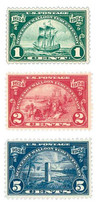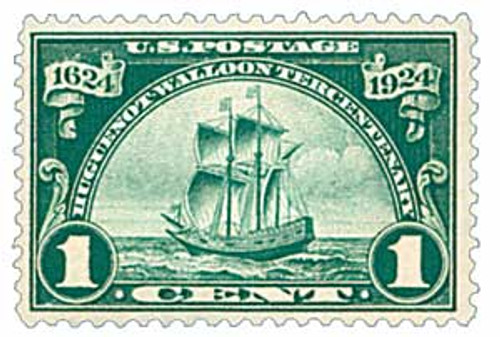
# 614-16 - Complete Set, 1924 Huguenot-Walloon Commemorative
Huguenot-Walloon Tercentenary
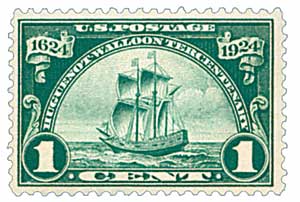
On May 1, 1924, the US Post Office issued a set of three stamps known as the Huguenot-Walloon Tercentenary Issue. The stamps honored the role of Protestant immigrants in settling America.
The Huguenots were French Protestants who, in the 16th century, established the first Presbyterian Church in France. After having their rights stripped by French King Louis XIV and Cardinal Richelieu, the Huguenots fled to other countries. When France sought to colonize the New World, the Huguenots were one of the first groups to attempt to build a permanent settlement in America nearly 60 years before the Pilgrims set foot on Plymouth Rock!
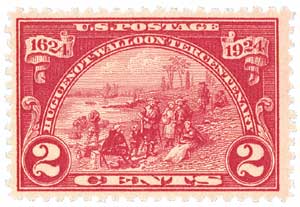
In 1564, the Huguenots established their colony at Fort Caroline on the St. Johns River in Florida. A stone column bearing the French coat of arms was erected to claim French sovereignty but Spain had different ideas. When King Philip II of Spain learned that France had set up this colony, he dispatched a naval commander to eradicate it and begin a Spanish settlement.
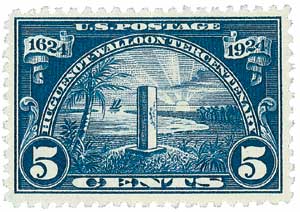
In 1566, the Spanish colony of St. Augustine was established nearby and eventually gained the title of America's first permanent settlement. In 1924, the Huguenot's stone column was replaced and dedicated as a memorial to those earlier settlers who had made their brave attempt.
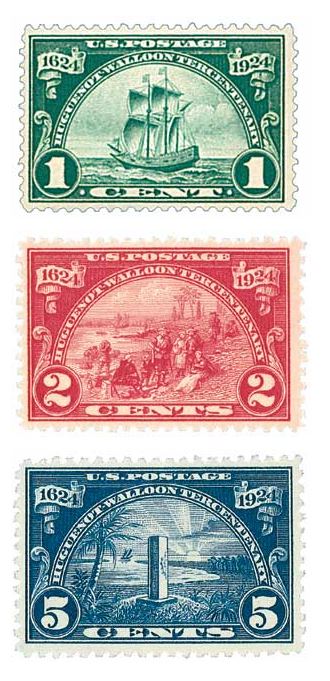
The Huguenots of France had fled to other countries as well, to find religious freedom. Those who arrived in Holland were given the name Walloons (foreigners). As fate would have it, these transplanted Huguenots were to become the first settlers Holland sent to the New World to establish its colonies in the Hudson River area. In 1624, the ship Nieu Nederland, set sail for America with 30 Walloon families.
On May 1, 1924, the US Post Office issued a set of three stamps honoring all this history. They selected this date to commemorate the 300th anniversary of the arrival of the Nieu Nederland Walloons. The stamps also honor that first settlement of French Huguenots in Florida.
The 1¢ stamp in the set pictures the ship Nieu Nederland. It usually paid the one-cent card rate or was used with other denominations to cover heavier mail and letters going to foreign destinations. The 2¢ stamp pictures Walloons landing at Fort Orange (Albany). It was mostly used to pay the first-class domestic rate but was also used on heavy and foreign mail. The 5¢ stamp was based on a sketch of the Jan Ribault Monument in Mayport, Florida. Like the other stamps, it was usually used on heavy and foreign mail.
Huguenot-Walloon Tercentenary

On May 1, 1924, the US Post Office issued a set of three stamps known as the Huguenot-Walloon Tercentenary Issue. The stamps honored the role of Protestant immigrants in settling America.
The Huguenots were French Protestants who, in the 16th century, established the first Presbyterian Church in France. After having their rights stripped by French King Louis XIV and Cardinal Richelieu, the Huguenots fled to other countries. When France sought to colonize the New World, the Huguenots were one of the first groups to attempt to build a permanent settlement in America nearly 60 years before the Pilgrims set foot on Plymouth Rock!

In 1564, the Huguenots established their colony at Fort Caroline on the St. Johns River in Florida. A stone column bearing the French coat of arms was erected to claim French sovereignty but Spain had different ideas. When King Philip II of Spain learned that France had set up this colony, he dispatched a naval commander to eradicate it and begin a Spanish settlement.

In 1566, the Spanish colony of St. Augustine was established nearby and eventually gained the title of America's first permanent settlement. In 1924, the Huguenot's stone column was replaced and dedicated as a memorial to those earlier settlers who had made their brave attempt.

The Huguenots of France had fled to other countries as well, to find religious freedom. Those who arrived in Holland were given the name Walloons (foreigners). As fate would have it, these transplanted Huguenots were to become the first settlers Holland sent to the New World to establish its colonies in the Hudson River area. In 1624, the ship Nieu Nederland, set sail for America with 30 Walloon families.
On May 1, 1924, the US Post Office issued a set of three stamps honoring all this history. They selected this date to commemorate the 300th anniversary of the arrival of the Nieu Nederland Walloons. The stamps also honor that first settlement of French Huguenots in Florida.
The 1¢ stamp in the set pictures the ship Nieu Nederland. It usually paid the one-cent card rate or was used with other denominations to cover heavier mail and letters going to foreign destinations. The 2¢ stamp pictures Walloons landing at Fort Orange (Albany). It was mostly used to pay the first-class domestic rate but was also used on heavy and foreign mail. The 5¢ stamp was based on a sketch of the Jan Ribault Monument in Mayport, Florida. Like the other stamps, it was usually used on heavy and foreign mail.



